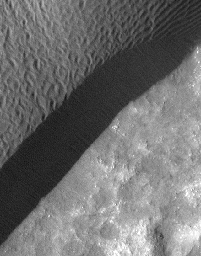
|
Rippling Dune Front in Herschel Crater on Mars
- Click the image above for a larger view
 Movie Download Options
Movie Download Options- Full-Res JPEG (878 x 1120) (119.5 kB)
- Full-Res TIFF (878 x 1120) (984.6 kB)
Caption:
A rippled dune front in Herschel Crater on Mars moved an average of about one meter (about one yard) between March 3, 2007 and December 1, 2010, as seen in these images from NASA's Mars Reconnaissance Orbiter. Note that the pattern of ripples on the dunesurface has changed completely between the two images. Herschel Crater is located just south of the equator in the cratered highlands.
This is one of several sites where the orbiter has observed shifting sand dunes and ripples. Previously, scientists thought sand on Mars was mostly immobile. It took the mission's High Resolution Imaging Science Experiment (HiRISE) to take sharp enough images to finally see the movement.
While dust is easily blown around the Red Planet, its thin atmosphere means that strong winds are required to move grains of sand.
Background Info:
The Mars Reconnaissance Orbiter is managed by NASA's Jet Propulsion Laboratory for NASA's Science Mission Directorate in Washington. The University of Arizona's Lunar and Planetary Laboratory operates HiRISE. The camera was built by Ball Aerospace & Technologies Corp. in Boulder, Colo. Johns Hopkins University Applied Physics Laboratory in Laurel, Md., provided and operates CRISM. JPL is a division of the California Institute of Technology in Pasadena.
Cataloging Keywords:
| Name | Value | Additional Values |
|---|---|---|
| Target | Mars | |
| System | ||
| Target Type | Planet | |
| Mission | Mars Reconnaissance Orbiter (MRO) | |
| Instrument Host | Mars Reconnaissance Orbiter | |
| Host Type | Orbiter | |
| Instrument | High Resolution Imaging Science Experiment (HiRISE) | Compact Reconnaissance Imaging Spectrometer for Mars (CRISM) |
| Detector | ||
| Extra Keywords | Atmosphere, Crater, Dune, Dust, Grayscale, Movie | |
| Acquisition Date | ||
| Release Date | 2011-11-17 | |
| Date in Caption | 2007-03-03 | 2010-12-01 |
| Image Credit | NASA/JPL-Caltech/Univ. of Ariz./JHUAPL | |
| Source | photojournal.jpl.nasa.gov/catalog/PIA14879 | |
| Identifier | PIA14879 | |
